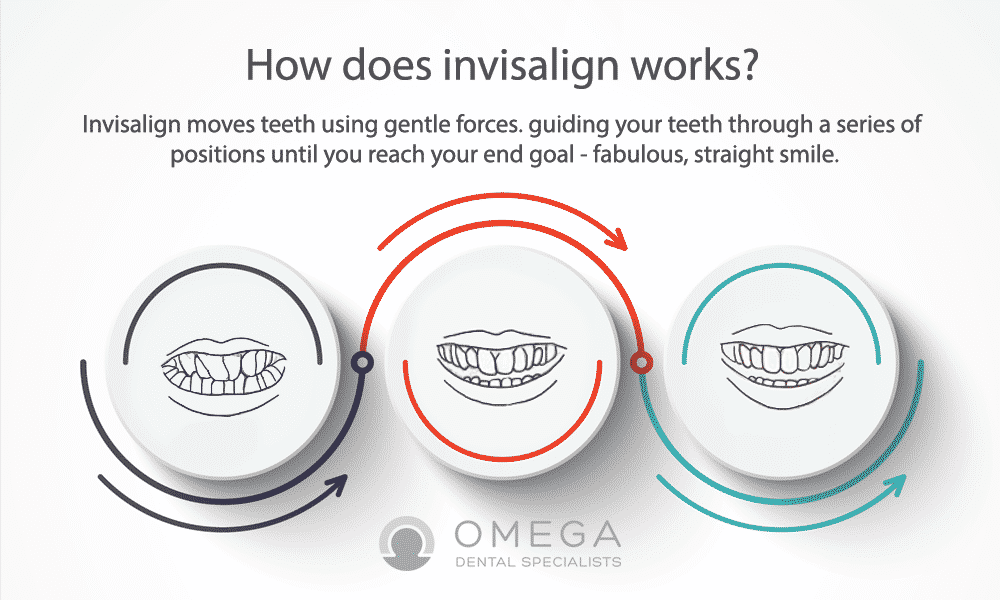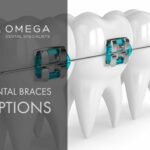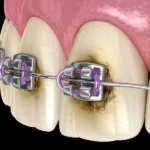How Does Invisalign Work?

Smart Force Technology
Align, the company behind Invisalign, researched extensively to create “Smart Force Technology.” It uses three dimensions of force to create a system that shifts teeth into alignment. Because Align has worked extensively on the process, Smart Force Technology can now correct nearly any orthodontic case—including under and overbite, crossbite and even issues involving space.
Invisalign is more popular today than it has ever been in the past. As popular as this teeth-straightening technology is, in fact, it is not for everyone. It is the perfect solution for many people while for others different options may indeed be much better. Considered to be one of the easiest and most comfortable methods of straightening teeth and dealing with other orthodontic issues. As a subtle way of fixing a smile, Invisalign uses transparent retainer-like type aligners that are very efficient in producing the desired teeth-shifting results.
There are cases that Invisalign may not be the best choice. The easiest way to determine whether a not this kind of treatment is right for you is to talk with your orthodontist. Your dentist can best help you in determining if you are a good candidate for this kind of treatment. Here are four primary considerations that should be taken into account:
1- Age Consideration
The age of the patient must be taken into account. Considered an ideal solution for adults and older teenagers, Invisalign may be less suitable for children and young teens.
Adults and older teenagers gain the most from clear aligner because of its transparency. Teenagers are usually highly susceptible to self-confidence and self-esteem related issues. Invisalign offers a good way to reduce social discomfort related issues. Traditional braces are for the most part very obvious and may interfere with normal social interaction so common with younger teenagers.
Adults as well as older teenagers often desire and prefer transparent teeth correcting technology like Invisalign. Many adults just wish to continue with their daily routine of work and social interaction without making it completely obvious that they are having their teeth straightened. This is why Invisalign is so popular among adults.
2- Degree Of Straightening Required
The overall level of teeth straightening needed often determines whether or not Invisalign is best suited for a particular patient. This is perhaps the most important determinant of whether or not an individual is indeed a good candidate for Invisalign. For example, Invisalign is not the best type of teeth straightening technology for fixing severely crooked teeth. Patients with severe orthodontic problems such as a large overbite may not be good candidates for Invisalign as well.
Conversely, Invisalign is in many ways the perfect choice for common or minor dental issues such as cross bites, under bites, overbites, and gapped teeth or even crowded teeth. In most cases, patients with the condition that is too severe for the use of Invisalign will have to choose another treatment option. These other options include traditional type metal braces in addition to newer technology such as clear braces. Talk with your dental care provider for the alternative treatments currently available today.
3- Patient’s Level Of Dedication
What makes Invisalign so unique is that it is removable and fully controllable by the patient. This makes Invisalign very comfortable and convenient regarding daily use. As a matter of fact, patients are required to remove aligners whenever they drink or eat. It is recommended that Invisalign is used for a minimum of 22 hours each day.
In short, if a patient is not completely dedicated to a successful treatment outcome, Invisalign only will not work. Indeed, the improper use of Invisalign can easily cause teeth to either fail to shift or to shift in the wrong way. Consult your dental care provider to learn more about the proper use of Invisalign and if it is the best option for you.
4- Take A Simple Test
Finally, to know for sure if Invisalign is right for you, it is wise to meet with your dental care provider to receive a free assessment or evaluation. When meeting with your dentist, you may be asked to provide general information about yourself and why you wish to correct your teeth alignment. This assessment or simple test can quickly determine whether or not the technology will be best suited to your particular case.
Having a consultation by meeting with your dentist will clear up any confusion about Invisalign and all that it has to offer. Patients should be prepared to choose an alternative treatment if the dentist determines that Invisalign is not the best solution. Invisalign is a new and excellent teeth straightening technology especially for those who want to fix their teeth in an invisible and almost undetectable way. With that being said, it is important to remember that the Invisalign system does not always fit the needs of everyone.
Is Invisalign A Treatment Plan for Every Patient?
Your orthodontist will create a custom Invisalign treatment plan that helps gently shift your teeth into place. In most cases, you will have around six separate sets of Invisalign aligners, Invisalign Express. Each changes your teeth a little further and eventually moves them closer to place. This customized plan is developed after the dentist takes x-rays and looks at your mouth’s shape. Then, the aligners are developed just for you.
Invisalign is an innovative, effective treatment for most of the orthodontic problems, such as spacing issues or rotation. Here, we’ve gathered the most common things we hear from patients who have completed their treatment regarding the things they wish they knew before Invisalign.
1- Choose an experienced Orthodontist
It’s important to choose an orthodontist who has extensive experience in Invisalign. An orthodontist is typically the best choice, but some dentists are very skilled in the application and management of Invisalign.
2- Dental insurance may cover your treatment.
Many patients put off starting Invisalign treatment because they believe it won’t be covered by insurance, but dental insurance plans with orthodontic coverage typically include Invisalign treatment per the plan guidelines (they commonly contribute $1,000 to $1,500 and sometimes more toward the total cost of Invisalign treatment). To read more about the cost of the treatment I refer you to one of our previous blogs about The Cost of Invisalign.
3- Invisalign doesn’t interfere with everyday life.
Because the clear aligners can be removed as needed (not to exceed four hours per day), Invisalign retainers don’t interfere dramatically with everyday life. They should be removed and cleaned after meals as well as before bed and in the morning, which requires a small time commitment throughout the day.
4- Invisalign might slightly affect your speech.
Some patients notice a slight lisp when wearing Invisalign trays. For some patients, the lisp improves over time, and for others, they experience throughout the course of treatment. Many patients notice no change in speech as a result of treatment.
5- The length of treatment varies from patient to patient.
Trays are usually changed every two weeks throughout the course of treatment, but your dentist may suggest you wear some trays for more or less time depending on your response to treatment. The total treatment period will depend on your unique case and desired results.
6- Invisalign might help you break bad habits.
Many patients limit bad habits like snacking throughout the day and drinking pop because of the work involved in cleaning the trays every time they do so. In fact, many patients report a healthy weight loss during their first few weeks of treatment.
7- Peroxide and water are the perfect cleaning solution.
Soaking your trays in a solution of 50% water, 50% peroxide for thirty minutes twice a week can remove staining and keep your trays as invisible as possible until it’s time to change trays. It can also help prevent bad breath.
8- Invisalign is affordable.
Invisalign is more affordable than many patients expect, and the new Invisalign Express is an especially low-priced option for patients who need minor adjustments to the spacing of their teeth. Scheduling a consultation appointment is the best way to get an accurate estimate of the cost of treatment.
How Often Do You Wear the Aligner Trays?
As the treatment progresses, patients will receive new aligners every few weeks. Each time new aligners are received you are advancing to the next stage of your Invisalign treatment. Your dental care provider will also do occasional checkups to monitor your teeth straightening progress. In most cases, patients can expect to have a consultation with their dental care provider regarding Invisalign treatment about every six weeks. One of the essential tips when it comes to successfully straightening teeth with Invisalign is to wear the aligners no less than 20 to 22 hours each day as discussed earlier. In short, when aligners are not being used, teeth are not being straightened. Your dental care provider will show you how your teeth are improving in overall alignment through each stage of the treatment. A beautiful smile has never been more easily achievable thanks to Invisalign and all that it makes possible. Modern dentistry and Invisalign make for a great smile. You may wear these aligners for 6 to 18 months, depending on the extent of your orthodontic problems
How does Invisalign Works?
All that is required of the patient is to simply wear the aligners throughout the day and night for a minimum of about 22 hours. The only time the aligners should be removed is when you brush, floss or eat. As time goes by the aligners will gently and gradually shift teeth into the correct alignment. Best of all, Invisalign is known for being almost virtually invisible to others. Most people will rarely even notice that you are wearing Invisalign aligners. Considered innovative and unique in many ways, Invisalign is becoming more popular each day as a smart and useful alternative to traditional braces. When it comes to straightening teeth, Invisalign is apparently becoming the method of choice. This is partly because it does not look like traditional braces with the typical brackets so often seen in metal braces.
Here is a basic primer on how Invisalign works and how it can help you enjoy a better quality of life with a more brilliant smile.
-
Schedule An Examination
Adults can expect typical Invisalign treatment to last about one year. Teens can expect Invisalign treatment to be comparable in length to the time required to straighten teeth using conventional braces. Your dental care provider will cover the exact details as to how long the treatment should be expected to last. Once an individual treatment plan has been formulated, the patient receives a series of custom-made, clear aligners that are made to the patient’s exact specifications. The aligners are unique in that they are very comfortable, smooth and designed not to irritate the cheeks or gums. This is in stark contrast to metal braces that often cause irritation and other problems. First, it is important to understand that Invisalign is very good at what it does. Also, there are certain circumstances where Invisalign is not the best choice for the patient. That said one of the best ways to make a highly informed decision about straightening teeth is to schedule an examination with your dental care provider simply. It is also worth mentioning that Invisalign is sometimes not the best choice for children who still have baby teeth or where their adult teeth have not fully developed. This is one instance where metal braces are clearly a better option.
-
Dental Impressions and X-rays
Once a patient has been determined to be a good candidate for Invisalign, the dental care provider will require a set of records to begin the treatment process. This includes taking photographs of the patient’s teeth and face as well as taking dental impressions of teeth along with getting several x-rays. Once these records have been collected and registered, they are sent off to Invisalign with detailed and accurate instructions on how to proceed regarding the way that the patient’s teeth should be moved. Once a patient has been determined to be an eligible candidate for Invisalign the next step is to have a series of x-rays. Routine x-rays along with impressions of your teeth and detailed pictures are combined and then used by your dental professional to map out a very precise Invisalign treatment program. Perhaps most important of all is that this pre-planning tracks the projected movement of teeth and the expected length of treatment based upon tooth movement. Your doctor will be able to present you with a virtual representation of how your teeth are expected to move throughout each stage of the Invisalign teeth straightening process.
-
Login And Review Teeth Movement
The next step in the process is for Invisalign to scan the patient’s impressions. This is so that there is a useful 3D model of the patient’s teeth stored in the computer system. Technicians will then virtually adjust the patient’s teeth in a step-by-step process using a computer-generated model to view the patient’s final teeth position ultimately. At any point in the process, the dental care provider can log in and review teeth movement via the computer generated 3D imaging. That said there are cases where a patient’s dental care provider may recommend changes regarding teeth positioning to the Invisalign technicians.
To achieve the best possible results regarding adjusting teeth, the dental care provider may make several changes along the way throughout the Invisalign preparation process. The primary objective is to gain as perfect results as possible about correctly aligning the patient’s teeth. Once all reviews and adjustments have been made, Invisalign will then proceed with making a series of trays or what is sometimes referred to as aligners.
The new aligners are sent to the dentist’s office where they can then be given to the patient to begin treatment. From the initial office visit to having aligners in hand usually takes about four weeks in total. Patients can expect to wear a set of Invisalign aligner trays for two weeks at a time. Each successive set of trays is manufactured in a way that allows teeth to move to a slightly straighter position each time.
Invisalign works by applying a slight amount of pressure over time to teeth to cause slight changes to occur. In most cases, teeth will move over the two-week period to match the set of aligner trays being worn. Other issues that must be considered when using Invisalign include crowded teeth. When a patient has crowded teeth, there are specific procedures that are used to ensure that Invisalign works efficiently. Talking with your dental care provider is the best way to understand in further detail how this is accomplished.
Also, there are circumstances where the patient may require something known as attachments to the teeth. Attachments are simply tooth colored small bumps that are made of plastic composite and that are attached to the teeth. These accessories are used to give a gripping point to the aligner trays. This helps the aligners perform more efficiently and stay in place better. It also applies pressure to the teeth in the direction that is needed to straighten more efficiently.
Fixed Or Permanent Retainer
Once all aligner trays have been used including the final set, it is the time for the patient to receive retainers. In most instances, clear plastic retainers that look very similar to Invisalign trays are used. One option includes receiving a fixed or permanent retainer that is placed inside the patient’s lower front teeth. This is essentially a wire that runs across the inside of the lower front six teeth of the patient’s mouth.
Retainers are typically worn continuously for a few months and then only worn while sleeping after that time. Retainers are primarily intended to help maintain the new teeth position achieved by the Invisalign treatment. Contact your dental care provider today to learn more about Invisalign and how it can help you gain a genuinely brilliant smile.





